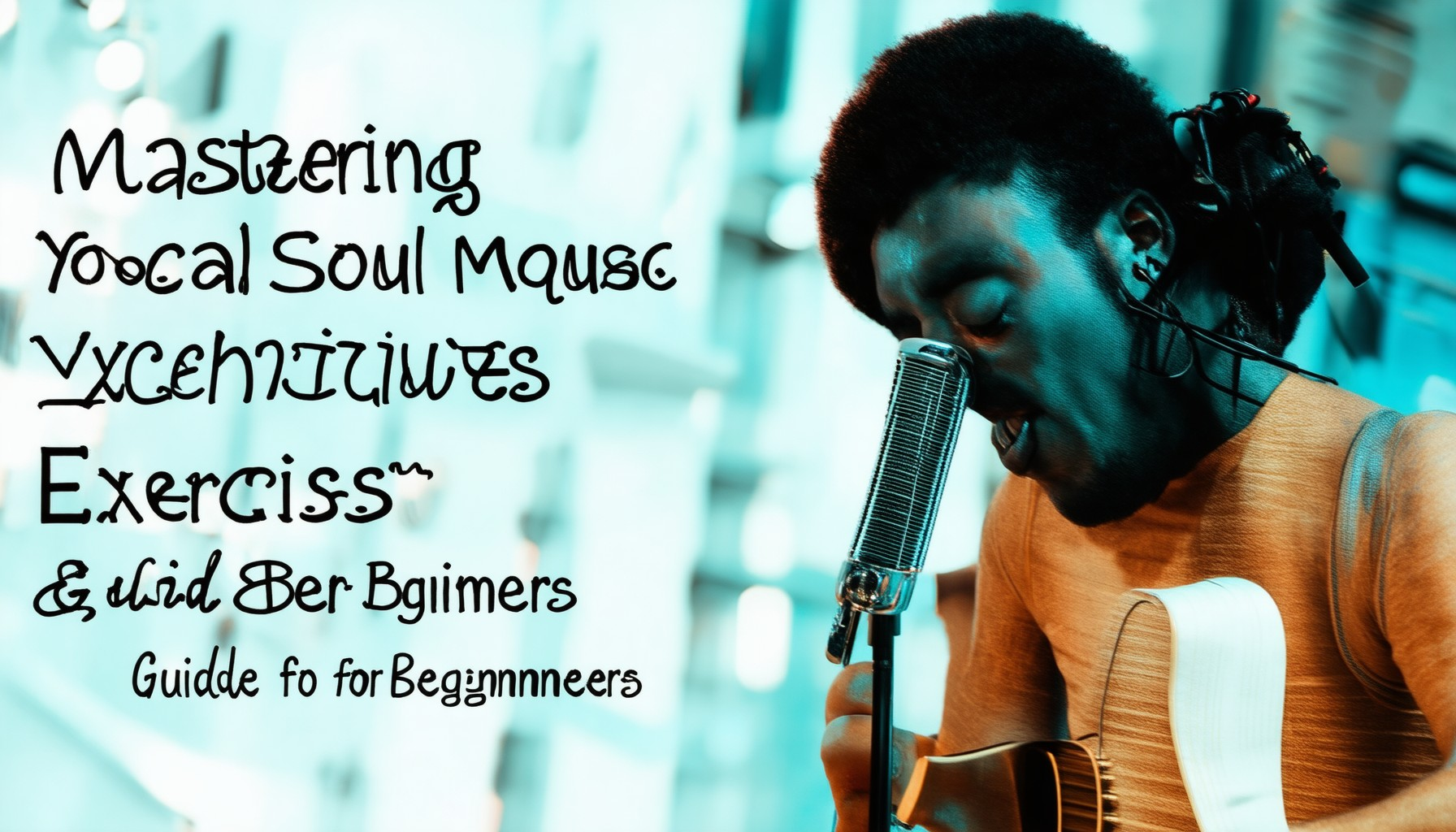Discovering the art of soul music vocal techniques can be both exhilarating and challenging. For aspiring singers, mastering the unique qualities of soul music requires not only talent but also dedication and the right guidance. Whether you’re a seasoned vocalist looking to refine your skills or a beginner eager to explore the depths of soulful expression, this guide offers practical exercises and insights to help you navigate the complexities of soul music vocal training. From understanding the core techniques to finding the right resources, this article dives into the essential practices that will elevate your vocal performance. Explore daily vocal exercises PDFs, piano accompaniment for warm-ups, and strategies to overcome common challenges. With the right approach, anyone can develop a powerful and expressive voice, embodying the essence of soul music. Dive in and unlock the secrets to becoming a confident and captivating singer.
Key Takeaways
- Train a bad voice to sing with dedication and consistent practice.
- Vocal exercises, mental health benefits, connecting with others, and the hard work of successful singers highlight the worthiness of singing.
- Find a vocal coach, practice regularly, master breathing techniques, expand your vocal range, and join a choir to improve your singing skills.
- Embrace challenges as opportunities for growth and development.
- Utilize resources from platforms like Tiger Funk for in-depth guides and inspiration.
- Perfect pitch isn’t required; relative pitch is sufficient for singing in tune.
- Enhance your singing abilities by starting with simple songs, practicing scales, seeking feedback, and maintaining proper posture and relaxation.

Common Vocal Techniques in Soul Music
Soul music, characterized by its deep emotional expression and rich harmonies, incorporates several distinctive vocal techniques. These techniques contribute to the genre’s unique sound and emotional impact:
- Melisma : Soul singers often employ melisma, where they sing multiple notes simultaneously. This technique adds layers of texture and emotional depth to the music, creating a lush, vibrant sound.
- Scat Singing : Improvisational scat singing allows artists to mimic instrumental sounds or create original melodies on the fly. This element is prominent in live performances and adds spontaneity and energy to soul tracks.
- Call and Response : A hallmark of soul music, this technique involves a lead vocalist calling out a phrase, followed by backing vocalists responding. This dynamic interaction fosters a sense of community and energy, exemplified by groups like The Temptations.
- Vibrato : The use of vibrato, rapid pitch fluctuations, gives voices their characteristic shine. This technique enhances expressiveness, helping convey the raw emotion central to soul music.
These techniques collectively shape the soulful, heartfelt delivery that has made this genre timeless.
How Can I Train Myself for Vocals?
To enhance your vocal skills, follow this structured plan focusing on daily exercises, breathing techniques, and consistent practice:
1. Warm-Up Exercises
- Humming:** Begin each session with 5-10 minutes of humming your favorite tunes. This engages your vocal cords gently.
- Breathing Techniques:** Practice diaphragmatic breathing by lying down and inhaling deeply, allowing your stomach to rise. Repeat several times daily.
2. Vocal Control and Range
- Vowel Sounds:** Practice each vowel sound (A, E, I, O, U) separately. Record yourself to hear differences and improvements.
- Articulation:** Work on pronouncing syllables slowly. Use tongue exercises to maintain steady articulation.
3. Scaling and Intervals
- Practice Scales:** Hold notes and move up/down by minor/major intervals using a piano or keyboard. Start simple, progress to complex scales.
4. Posture and Projection
- Posture:** Maintain good posture, standing or sitting tall to support breathing and projection. Avoid slouching.
5. Strength and Power
- Vocal Exercises:** Incorporate exercises like humming and scales. Dedicate 15-20 minutes daily to these.
- BELTING:** Practice projecting notes with power. Start with familiar songs, using a mirror to observe facial expressions.
6. Song Learning and Application
- New Songs:** Learn songs within your vocal range. Regular practice builds confidence and technique.
- Cover Songs:** Mimic famous singers to learn their nuances, choosing songs that match your range.
7. Feedback and Care
- Self-Recording:** Record sessions for feedback. Listen back to track progress and identify areas for improvement.
- Health Care:** Prioritize rest, hydration, and avoid harmful habits. Monitor for signs of vocal strain.
8. Resources and Environment
- Technology:** Use vocal training apps for guided exercises and tracks. Analyze professional singers’ techniques online.
- Environment:** Practice in a quiet space. Use noise-canceling headphones to minimize distractions.
9. Consistency and Motivation
- Set Goals:** Establish realistic objectives and maintain a routine. Track progress to monitor growth.
- Motivation:** Celebrate small achievements to stay motivated and focused on improvement.
By following this structured plan, you can develop your vocal skills effectively, incorporating daily exercises, mindful practice, and consistent effort.

What Exercises Improve Your Speaking Voice?
To enhance your speaking voice, incorporating targeted exercises can lead to improved clarity, confidence, and projection. Here’s a structured approach:
- Breathing Techniques :
- Practice diaphragm engagement: Inhale deeply through your nose, letting your belly rise. Exhale slowly through pursed lips, feeling your chest stay still.
- Perform the “Shepard’s Purse” exercise: Sit comfortably, place one hand on your chest and the other on your abdomen. Inhale through your nose until you feel your chest rise, then exhale forcefully through your mouth while counting to four. Repeat 5-10 times.
- Tongue Exercises :
- Stick out your tongue and move it side to side rapidly. Hold for 5 seconds, then relax. Repeat several times.
- Practice “Mouth Exercises”: Open your mouth wide, like a yawn, and hold for 5 seconds. Close it quickly and repeat.
- Vowel Sounds :
- Practice different vowel phonations: /a/, /e/, /i/, /o/, /u/. Try holding each sound for 2-3 seconds and notice the resonance in your throat.
- Use a straw: Sip water through a straw while trying to articulate clear vowel sounds. This helps train your tongue and lips.
- Articulation Drills :
- Practice the “Ah” sound: Open your mouth wide and say “Ah” for 5-10 seconds. Feel the vibration in your throat.
- Work on sibilants: Practice saying “sh”, “zh”, “ch”, etc., focusing on the fricative sounds. Move your tongue quickly and accurately.
- Tongue Twisters :
- Recite tongue twisters like “She sells seashells by the seashore” repeatedly. This improves your ability to articulate quickly and clearly.
- Daily Practice Tips :
- Speak slowly and enunciately during practice sessions.
- Record yourself speaking and listen for areas needing improvement.
- Avoid speaking too much without warm-up exercises.
By consistently practicing these exercises, you can develop a stronger, clearer, and more expressive speaking voice. For further insights, explore Tiger Funk’s articles on breathing techniques , articulation , and vocal health .

Yes, You Can Train a Bad Voice to Sing
Singing is a skill that can be developed with dedication and practice, regardless of your initial voice quality. While some may inherit a naturally beautiful singing voice, others may find theirs to be less than ideal. However, with the right approach, anyone can improve their singing abilities and train their voice to become more confident and skilled.
Why Singing is Worthwhile
- Vocal exercises can significantly improve your singing ability over time.
- Singing is excellent for mental health and emotional well-being.
- It helps you connect with others through music and storytelling.
- Many successful singers had to work hard to develop their voices.
Steps to Improve Your Singing Voice
- Find a Vocal Coach: A professional can provide personalized advice and exercises tailored to your needs.
- Practice Regularly: Consistency is key. Even 15–30 minutes daily can lead to noticeable progress.
- Work on Breathing Techniques: Proper breathing is essential for controlling your voice and pitch.
- Expand Your Range: Practice singing in different registers to increase your vocal flexibility.
- Join a Choir or Singing Group: Collaborating with others can provide motivation and feedback.
Overcoming Challenges
Every singer faces challenges, whether it’s overcoming stage fright or dealing with vocal strain. The key is to embrace these challenges and view them as opportunities for growth. With patience and persistence, you can overcome these obstacles and develop a stronger, more confident singing voice.
Resources to Help You Succeed
To further enhance your singing skills, explore resources available on platforms like Tiger Funk . Their articles offer in-depth guides, artist profiles, and historical insights into music genres that can inspire and educate aspiring singers.
Remember, success in singing isn’t just about talent—it’s about effort, perseverance, and a willingness to grow. With the right guidance and consistent practice, anyone can train their voice to sing beautifully.
Can You Learn to Sing if You Can’t Carry a Tune?
Yes, you can learn to sing even if you struggle with carrying a tune. Perfect pitch is not a prerequisite for singing in tune. Most people, including professional musicians, do not possess perfect pitch, yet they can still sing harmoniously.
Understanding Pitch
- Relative Pitch : This is the ability to match pitches to a melody you hear, which is sufficient for most singing purposes. Even without perfect pitch, you can develop this skill through practice.
- Perfect Pitch : While rare, it involves identifying notes by ear without hearing them played. However, it’s not essential for singing in tune.
Practical Steps to Improve Singing
- Start Simple: Begin with familiar songs or exercises that focus on basic melodies and rhythms.
- Listen and Match: Practice matching pitches to songs you already know. This helps train your ear to recognize and replicate tones.
- Practice Scales: Work on major and minor scales to build a foundation in musical intervals.
- Seek Feedback: Sing along with others or record yourself to identify areas for improvement.
- Breathing Techniques: Master diaphragmatic breathing to support your voice effectively.
- Posture and Relaxation: Maintain good posture and relax to allow your voice to resonate freely.
By consistently applying these techniques, anyone can enhance their singing abilities and enjoy singing in tune.

Top Songs for Bad Voices
If you’re looking for songs that are easy to sing, regardless of your vocal abilities, here are some recommendations:
- Sweet Caroline by Neil Diamond – Known for its catchy and repetitive lyrics, this song is perfect for engaging the crowd and ensuring a memorable performance.
- I Am a Star by Mariah Carey – With its strong beat and simpler lyrics, this track is ideal for those who struggle with singing complexity.
- Can’t Help Falling in Love by Elvis Presley – A slow, romantic ballad that allows you to focus on the melody without the pressure of hitting high notes.
- Imagine by John Lennon – A slower, reflective song that shifts attention away from vocal prowess, allowing you to connect with the lyrics.
- Hound Dog by Elvis Presley – An upbeat, energetic rock ‘n’ roll song that’s fun and forgiving for less experienced singers.
- Jailhouse Rock by Elvis Presley – Another Elvis classic with a catchy rhythm and simple lyrics, perfect for keeping the energy high.
- Uptown Funk by Mark Ronson feat. Bruno Mars – A modern, funky track with a memorable chorus, ideal for those who prefer a more contemporary sound.
- Happy by Pharrell Williams – An upbeat, cheerful song with simple, repetitive lyrics that are easy to sing and fun to perform.
- We Are Family by Sister Sledge – An empowering anthem with a strong, uplifting message and a memorable chorus, perfect for building confidence and energy.
These songs are chosen for their ease of singing, catchy melodies, and ability to enhance your performance despite any vocal challenges. Whether you’re performing alone or with friends, these tracks are sure to make your experience enjoyable and memorable!





0 Comments